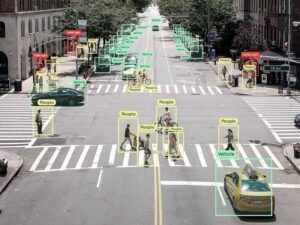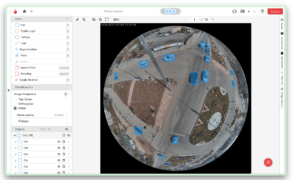High-quality annotated image data is the foundation of any successful computer vision AI model. From object detection and segmentation to complex medical imaging and autonomous vehicle perception, the annotation tool you choose shapes your model’s accuracy, scalability, and deployment readiness.

Not all annotation platforms are equal. Some excel at automation and scalable workflows, others focus on niche use cases like medical imaging, while a few offer deep customization and open-source control. This guide reviews eight leading image annotation tools widely used by AI teams across industries, highlighting their core features and strengths.
Key Features to Look for in Image Annotation Tools
Before exploring the top tools, here are the key features to consider:
- Annotation versatility: Support for bounding boxes, polygons, keypoints, segmentation masks, and 3D annotations.
- Automation capabilities: Model-assisted labeling, pre-labeling, active learning, and human-in-the-loop
- Collaboration and quality control: Multi-user workflows, audit trails, consensus reviews, and error detection.
- Data and deployment flexibility: Support for large datasets, secure cloud/on-prem options, and integration APIs.
- Domain-specific support: Tools optimized for medical imaging formats (DICOM, NRRD), autonomous driving data, or general computer vision.
1. iMerit Ango Hub

iMerit Ango Hub is purpose-built for complex, high-stakes annotation workflows, especially in healthcare and autonomous mobility. It combines advanced automation with a specialized expert workforce, including certified radiologists, to deliver clinical-grade annotation quality and compliance readiness.
Key Features:
- Pixel-level segmentation, bounding boxes, keypoints, and more — rigorously vetted by in-house expert teams.
- Full support for medical imaging formats such as DICOM, NRRD, NIfTI, plus multimodal data like point clouds and LiDAR.
- Flexible deployment options: on-premises, hybrid cloud, or private cloud.
- Enterprise-grade security controls with detailed audit trails and compliance with HIPAA and GDPR.
- Robust quality assurance through consensus-based expert review pipelines, annotation validation loops, and scoring.
- A integrated with human-in-the-loop workflows to ensure precision and regulatory readiness.
Ango Hub’s automation suite includes model-assisted pre-labeling to give annotators a high-accuracy starting point, active learning loops that flag and prioritize edge cases for expert review, and real-time validation scripts that detect errors or inconsistencies during labeling. These automated checks are seamlessly combined with reviews from domain specialists, such as certified radiologists, to maintain both speed and compliance with standards like HIPAA and FDA guidelines.
What makes iMerit stand out: Unlike many platforms that rely on generic reviewers, Ango Hub integrates domain experts directly into annotation pipelines, ensuring data quality meets regulatory and clinical standards. What makes iMerit stand out is its Radiology Annotation Product Suite, which seamlessly integrates sourcing, workflow design, tooling, automation, analytics, and expert-in-the-loop validation within a single platform.
2. Dataloop
Dataloop is an end-to-end data engine built for managing and automating data annotation workflows in computer vision projects. It supports scalable pipelines across industries like retail, robotics, and automotive.
Features:
- An annotation studio with multiple tools and ontologies.
- Embedded AI pre‑annotation and conversion (bounding boxes → masks).
- QA workflows and workforce/project management.
- High GDPR, ISO 27001, and SOC 2 compliance.
3. Encord
Encord is a data-centric annotation platform designed for AI teams that need collaborative workflows and strong quality assurance. It’s particularly favored in medical AI due to its compliance-first approach and support for 3D, video, and complex imaging modalities.
Features:
- Supports hierarchical ontologies and object relationships
- Real-time collaboration and task assignments for large teams
- AI-assisted labeling with active learning prioritization
- Smart data curation and slicing tools
- HIPAA/GDPR compliant with secure enterprise deployments
4. Cogito Tech
Cogito Tech offers specialized annotation services with a strong focus on medical imaging, including radiology and pathology datasets. The platform combines AI-assisted workflows with human expertise, enabling faster labeling while maintaining clinical-grade precision. Their structured validation processes and domain-specific QA pipelines make them a common partner for healthcare AI companies looking to build FDA-cleared models.
Key Features:
- AI-assisted workflows for medical image segmentation and classification
- Automated quality control systems with scoring mechanisms
- Multi-user review workflows for high-stakes medical data
- Access to medically trained annotators and SMEs
- Custom validation pipelines for regulatory alignment
5. Annot.ai (or Annotate.ai)
Annot.ai positions itself as a lightweight, flexible tool tailored to computer vision teams focused on object detection, segmentation, and classification tasks. It’s built for rapid deployment and easy integration with model training pipelines, with the added benefit of human-in-the-loop capabilities that allow iterative model tuning and real-time annotation correction.
Key Features:
- Intuitive interface for bounding boxes, polygons, and masks
- Pre-labeling and automation workflows to speed up annotation
- Native integration with ML pipelines via APIs and SDKs
- Feedback loop support for model performance improvement
- Designed for lean teams working on fast iteration cycles
6. V7 Labs
V7 Labs’ platform is designed for complex image and video annotation, including medical imaging workflows, with strong automation and collaboration features. It supports advanced labeling tasks like polygon segmentation, instance tracking, and model-assisted pre-labeling. Teams benefit from intuitive UI, scalable project management, and integrations with training pipelines for faster iteration.
Key Features:
- Supports bounding boxes, polygons, masks, and 3D point clouds
- AI-assisted labeling with active learning and model-in-the-loop
- Collaboration tools for distributed teams with task tracking
- Integration APIs and workflow customization
- Compliance-ready with audit trails and secure data handling
7. SuperAnnotate
SuperAnnotate delivers an enterprise-grade platform focused on scaling high-volume image and video annotation with advanced QA and project management tools. Designed to combine human and AI inputs seamlessly, it supports use cases across industries—from autonomous driving to retail and healthcare—while enabling teams to manage large annotation pipelines without losing accuracy or speed.
Key Features:
- AI-assisted labeling with smart suggestions and bulk tools
- Integrated project and workforce management dashboard
- Customizable QA workflows with reviewer assignment
- Ontology and taxonomy versioning for complex use cases
- Integrations with MLOps tools for model iteration
8. Roboflow
Roboflow is a developer-centric platform that helps machine learning teams go from data to a deployed model quickly. While not a pure annotation platform, it excels in preprocessing, format conversion, augmentation, and auto-labeling for computer vision workflows. Roboflow is especially popular among startups and researchers for its ease of use and ready integration with major training frameworks.
Key Features:
- Auto-labeling using model inference or foundation model APIs
- Dataset versioning, augmentation, and error analytics
- 30+ annotation format conversions for seamless workflow
- Exports directly to YOLO, Detectron2, TensorFlow, etc.
- Ideal for experimentation, rapid prototyping, and deployment
Conclusion: Choosing the Right Image Annotation Tool for Your Computer Vision Project
Selecting the right image annotation tool depends on your project’s scale, domain, and quality requirements. For teams prioritizing clinical-grade medical imaging annotation with expert-in-the-loop validation, iMerit Ango Hub offers unmatched domain expertise combined with flexible, secure deployment options.
Whether you’re managing complex healthcare datasets or building scalable computer vision workflows across industries, the right tool can streamline your labeling, improve annotation accuracy, and accelerate your model’s time to production.
Explore how Ango Hub’s expert workforce, automation, and regulatory-ready infrastructure can power your next computer vision project with precision and confidence.
